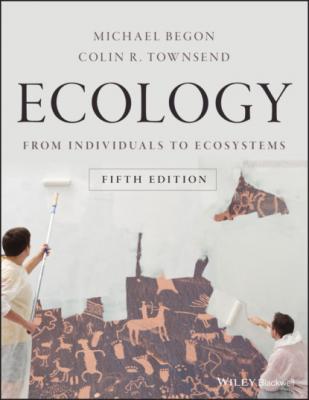Ecology. Michael Begon
Читать онлайн.| Название | Ecology |
|---|---|
| Автор произведения | Michael Begon |
| Жанр | Биология |
| Серия | |
| Издательство | Биология |
| Год выпуска | 0 |
| isbn | 9781119279310 |
But there is, of course, no vegetation that consists entirely of one growth form. All vegetation contains a mixture, a spectrum, of Raunkiaer’s life forms. The composition of the spectrum in any particular habitat is as good a shorthand description of its vegetation as ecologists have yet managed to devise. Raunkiaer compared these with a ‘global spectrum’ obtained by sampling from a compendium of all species known and described in his time (the Index Kewensis), biased by the fact that the tropics were, and still are, relatively unexplored. Thus, for example, we recognise a chaparral type of vegetation when we see it in Chile, Australia, California or Crete because the life form spectrums are similar. Their detailed taxonomies would only emphasise how different they are.
APPLICATION 1.6 Stream invertebrate species traits and agricultural pollution
While plant scientists have tended to be keener on classifying floras than animal scientists on classifying faunas, an analogous approach can be of use to resource managers. For example, agriculture in the catchment area of streams can have profound impacts on the invertebrate communities they contain, and just as with Raunkiaer's classification of plants, the patterns may be more closely related to species traits (paralleling Raunkiaer's life form spectra) than to taxonomic composition. Doledec et al. (2006) found that traits associated with population resilience (the ability to bounce back following perturbations), including short generation time and hermaphroditic reproduction, became more prevalent with increasing agricultural intensity in the catchment, reflecting more frequent and intense variations in stream nutrient concentrations (Figure 1.25). There was also a shift away from laying eggs at the water surface and a decrease in gill respiration, reflecting the increasing likelihood of smothering by sediment introduced as a result of ploughing or disturbance of soil and stream banks by grazing animals. The representation of these and other species traits can be used to devise indexes and thresholds of stream health that managers can aspire to attain or restore (Serra et al., 2017).
Figure 1.25 Species traits in streams. Relationships between the representation of species traits of stream invertebrates (% of individuals possessing the trait in the multispecies community as a whole) and the intensity of agriculture in the catchment area of the stream. None, ungrazed native tussock grassland; low, grazed native tussock grassland; medium, extensively grazed pasture; high, dairy or deer farming. Plurivoltine, more than one generation per year; short lives, 10–30 days; hermaphroditism, one individual possessing both sexes; surface eggs, laying unattached eggs at the stream surface; gill respiration, having external gills.
Source: From Doledec et al. (2006).
1.6 The diversity of matches within communities
Although a particular type of organism is often characteristic of a particular ecological situation, it will almost inevitably be only part of a diverse community of species. A satisfactory account, therefore, must do more than identify the similarities between organisms that allow them to live in the same environment – it must also try to explain why species that live in the same environment are often profoundly different. To some extent, this ‘explanation’ of diversity is a trivial exercise. It comes as no surprise that a plant utilising sunlight, a fungus living on the plant, a herbivore eating the plant and a parasitic worm living in the herbivore should all coexist in the same community (food webs will be discussed in Chapter 17 and the flow of energy and nutrients through ecosystems in Chapters 20 and 21). On the other hand, most communities also contain a variety of different species that are all constructed in a fairly similar way and all living (at least superficially) a fairly similar life. We have seen excellent examples among the finches of the Galápagos (Figure 1.9), the cichlid fish of Lake Apoyo (Figure 1.11), the Howea palms of Howe Island (Figure 1.12), and the picture‐winged fruit‐flies of Hawaii (Figure 1.16). There are several elements in an explanation of this diversity.
environments are heterogeneous
A completely homogeneous environment might well become dominated by one or a very few species that are well adapted to the conditions and resources there. But there are no homogeneous environments in nature. Even a continuously stirred culture of microorganisms is heterogeneous because it has a boundary – the walls of the culture vessel – and cultured microorganisms often subdivide into two forms: one that sticks to the walls and the other that remains free in the medium.
The extent to which an environment is heterogeneous depends on the scale of the organism that senses it. To a mustard seed, a grain of soil is a mountain; and to a caterpillar, a single leaf may represent a lifetime’s diet. A seed lying in the shadow of a leaf may be inhibited in its germination while a seed lying outside that shadow germinates freely. What appears to the human observer as a homogeneous environment may, to members of species within it, be a mosaic of the intolerable and the adequate.
There may also be gradients in space (e.g. altitude) or gradients in time, and the latter, in their turn, may be rhythmic (like daily and seasonal cycles), directional (like the accumulation of a pollutant in a lake) or erratic (like fires, hailstorms and typhoons).
Heterogeneity crops up again and again in later chapters – in part because of the challenges it poses to organisms in moving from patch to patch (Chapter 6), in part because of the variety of opportunities it provides for different species (Chapters 2 and 3), and in part because heterogeneity can alter communities by interrupting what would otherwise be a steady march to an equilibrium state of a few species (
